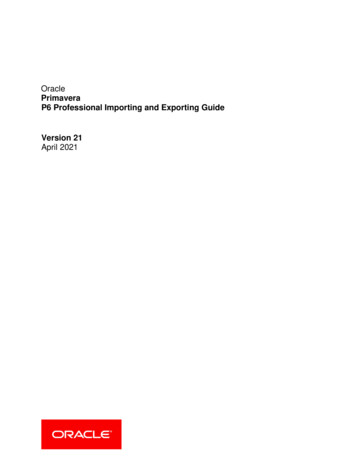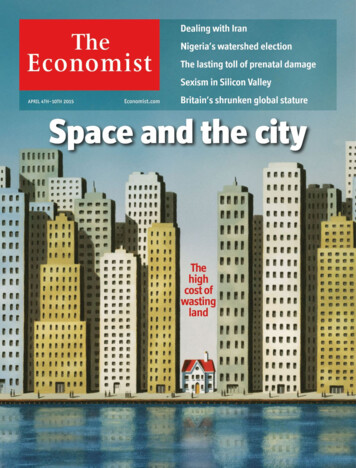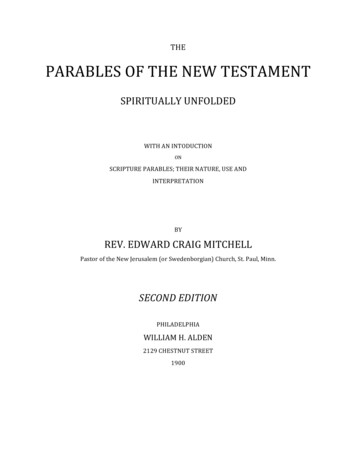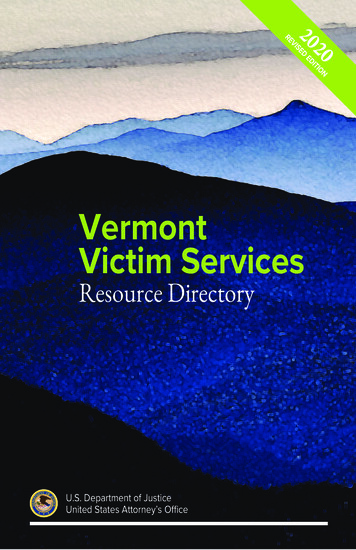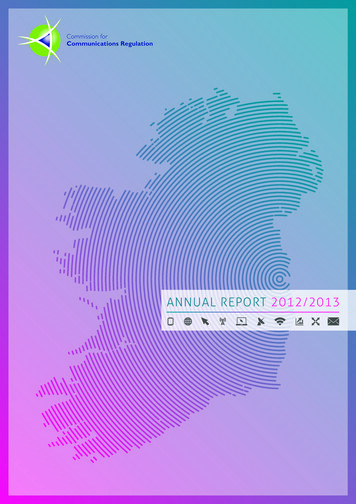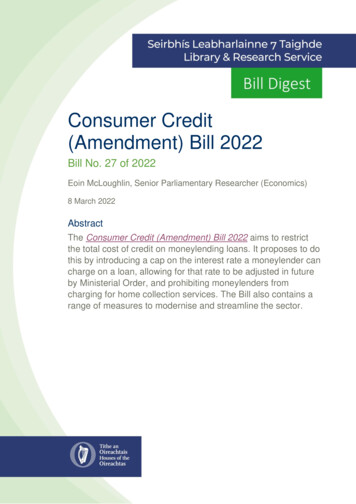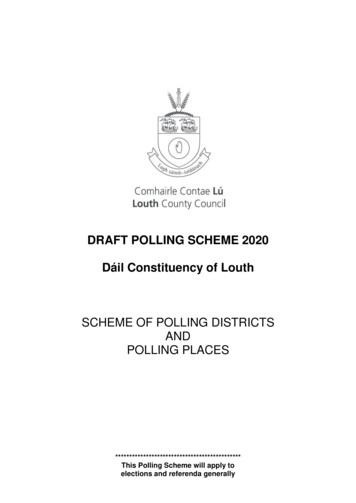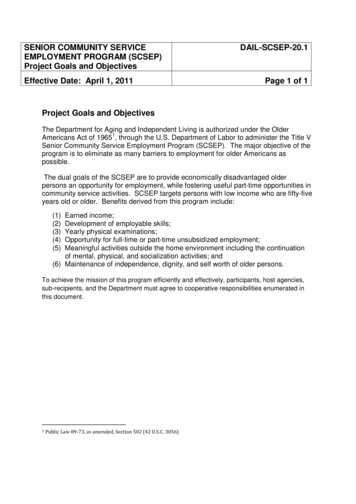
Transcription
SENIOR COMMUNITY SERVICEEMPLOYMENT PROGRAM (SCSEP)Project Goals and ObjectivesEffective Date: April 1, 2011DAIL-SCSEP-20.1Page 1 of 1Project Goals and ObjectivesThe Department for Aging and Independent Living is authorized under the OlderAmericans Act of 19651, through the U.S. Department of Labor to administer the Title VSenior Community Service Employment Program (SCSEP). The major objective of theprogram is to eliminate as many barriers to employment for older Americans aspossible.The dual goals of the SCSEP are to provide economically disadvantaged olderpersons an opportunity for employment, while fostering useful part-time opportunities incommunity service activities. SCSEP targets persons with low income who are fifty-fiveyears old or older. Benefits derived from this program include:(1)(2)(3)(4)(5)Earned income;Development of employable skills;Yearly physical examinations;Opportunity for full-time or part-time unsubsidized employment;Meaningful activities outside the home environment including the continuationof mental, physical, and socialization activities; and(6) Maintenance of independence, dignity, and self worth of older persons.To achieve the mission of this program efficiently and effectively, participants, host agencies,sub-recipients, and the Department must agree to cooperative responsibilities enumerated inthis document.1Public Law 89-73, as amended, Section 502 (42 U.S.C. 3056)
SENIOR COMMUNITY SERVICEEMPLOYMENT PROGRAM (SCSEP)DefinitionsEffective Date: April 1, 2011DAIL-SCSEP-20.2Page 1 of 10DefinitionsThe following definitions apply to the operation of this program:(1) Additional indicators mean retention in unsubsidized employment for one year;satisfaction of participants, employers and their host agencies with theirexperiences and the services provided; and any other indicators ofperformance.(2) At risk for homelessness means an individual is likely to become homelessand the individual lacks the resources and support networks needed to obtainhousing.(3) Authorized position level means the number of SCSEP enrollmentopportunities that can be supported for a 12-month period based on theaverage national unit cost. The authorized position level is derived by dividingthe total amount of funds appropriated for a Program Year by the nationalaverage unit cost per participant for that Program Year. The national averageunit cost includes all costs of administration, other participant costs, andparticipant wage and benefit costs as defined in Section 506(g) of the OAA.(4) Co-enrollment applies to any individual who meets the qualifications forSCSEP participation and is also enrolled as a participant in WIA or anotheremployment and training program, as provided in the Individual EmploymentPlan.(5) Community service1 means (1) Social, health, welfare, and educationalservices (including literacy tutoring), legal and other counseling services andassistance, including tax counseling and assistance and financial counseling,and library, recreational, and other similar services; (2) Conservation,maintenance, or restoration of natural resources; (3) Community betterment orbeautification; (4) Antipollution and environmental quality efforts; (5)Weatherization activities; (6) Economic development; and (7) other suchservices essential and necessary to the community.(6) Community service assignment2 means part-time, temporary employment paid1(OAA Sec. 518(a)(1))2(OAA Sec. 518 (a) (2)).
SENIOR COMMUNITY SERVICEEMPLOYMENT PROGRAM (SCSEP)DefinitionsEffective Date: April 1, 2011DAIL-SCSEP-20.2Page 2 of 10with grant funds in projects at host agencies through which eligible individualsare engaged in community services and receive work experience and job skillsthat can lead to unsubsidized employment.(7) Core indicators3 means hours (in the aggregate) of community serviceemployment; entry into unsubsidized employment for six months; earnings; thenumber of eligible individuals served; and most-in-need (the number ofindividuals described in Sect 518 (a)(3)(B)(ii) or (b)(2) of the OAA).(8) Core services means those services describe in Sec. 134(d) (2) of WIA.(9) Department or DAIL means the Department for Aging and Independent Livingincluding organizational units.(10) Disability4 means a disability attributable to a mental or physical impairment, ora combination of mental and physical impairments, that results in substantialfunctional imitations in one or more of the following areas of major life activity:(a) Self-care;(b) Receptive and expressive language;(c) Learning;(d) Mobility(e) Self-direction;(f) Capacity for independent living;(g) Economic self-sufficiency;(h) Cognitive functioning; and(i) Emotional Adjustment(11) Equitable distribution report means a report based on the latest availableCensus or other reliable data, which lists the optimum number of participantpositions in each designated area in the State, and the number of authorizedparticipant positions each grantee serves in that area, taking into account theneeds of underserved counties and incorporated cities as necessary. Thisreport provides a basis for improving the distribution of SCSEP positions.(12) Frail means an individual 55 years of age or older who is determined to be34(OAA Sec. 513 (b) (1)(42 U.S.C. 3002 (13))
SENIOR COMMUNITY SERVICEEMPLOYMENT PROGRAM (SCSEP)DefinitionsEffective Date: April 1, 2011DAIL-SCSEP-20.2Page 3 of 10functionally impaired because the individual(a) (i) Is unable to perform at least two activities of daily living withoutsubstantial human assistance, including verbal reminding,physical cueing, or supervision; or(ii) At the option of the State, is unable to perform at least threesuch activities without such assistance; or(b) Due to a cognitive or other mental impairment, requiressubstantial supervision because the individual behaves in amanner that poses a serious health or safety hazard to theindividual or to another individual.(13) Local government 5means a public agency or private non-profit organization,other than a political party, exempt from taxation under the provision of Section501(c)(3) of the Internal Revenue Code of 1954, which provides a worksiteand supervision for an enrollee.(14) Greatest economic need6 means the need resulting from an income level at orbelow the poverty guidelines established by the Department of Health andHuman Services and approved by the Office of Management and Budget(OMB).(15) Greatest social need means the need caused by non-economic factors, whichinclude: Physical and mental disabilities; language barriers; and cultural, social,or geographical isolation, including isolation caused by racial or ethnic status,which restricts the ability of an individual to perform normal daily tasks orthreatens the capacity of the individual to live independently. (42 U.S.C.3002)24))(16) Homeless Includes:(a) An individual who lacks a fixed regular, and adequate nighttimeresidence; and(b) An individual who has a primary nighttime residence that is:(i) A supervised publicly or privately operated shelter designed toprovide temporary living accommodations (including welfare5(42 U.S.C. 3002(22))6(42 U.S.C. 3002(23))
SENIOR COMMUNITY SERVICEEMPLOYMENT PROGRAM (SCSEP)DefinitionsEffective Date: April 1, 2011DAIL-SCSEP-20.2Page 4 of 10hotels, congregate shelters, and transitional housing for thementally ill;(ii) An institution that provides a temporary residence forindividuals intended to be institutionalized; or(iii) A public or private place not designed for, or ordinarily usedas regular sleeping accommodations for human beings7.(17) Host agency8 means s public agency or a private nonprofit organizationexempt from taxation under Section 501 (c) (3) of the Internal Revenue Codeof 1986 of which provides a training work site and supervision for one or moreparticipants. Political parties cannot be host agencies. A host agency may bea religious organization as long as the projects in which participants are beingtrained do not involve the construction, operation, or maintenance of anyfacility used or to be used as a place for sectarian religious instruction orworship.(18) Individual employment plan (IEP)9 means a plan that is based on anassessment of that participant conducted by the sub-recipient, or a recentassessment or plan developed by another employment and training program,and a related service strategy. The IEP must include an appropriateemployment goal (except that after the first IEP, subsequent IEPs need notcontain an employment goal if such a goal is not feasible), objectives that leadto the goal, a timeline for the achievement of the objectives; and be jointlyagreed upon with the participant.(19) Intensive services mean those services authorized by Sec. 134 (d) (3) of theWorkforce Investment Act.(20) Jobs for Veterans Act10 means Public Law 107-288 (2002). Section 2(a)of the Jobs for Veterans Act, codified at 38 U.S.C. 4215(a) provides a priorityof service for Department of Labor employment and training programs for7(42 U.S.C. 11302(a))8(OAA Sec. 502 (b) (1) (D))9(OAA Sec. 502 (b) (1) (N))10(Sec. 641. 520 (b))
SENIOR COMMUNITY SERVICEEMPLOYMENT PROGRAM (SCSEP)DefinitionsEffective Date: April 1, 2011DAIL-SCSEP-20.2Page 5 of 10veterans, and certain spouses of veterans, who otherwise meet the eligibilityrequirements for participation. Priority is extended to veterans. Priority is alsoextended to the spouse of a veteran who died of a service-connecteddisability; the spouse of a member of the Armed Forces on active duty whohas been listed for a total of more than 90 days as missing in action, capturedin the line of duty by a hostile force, or forcibly detained by a foreigngovernment or power; the spouse of any veteran who has a total disabilityresulting from a service-connected disability; and the spouse of any veteranwho died while a disability so evaluated was in existence.(21) Job ready refers to individuals who do not require further education or trainingto perform work that is available in their labor market.(22) Limited English proficiency means individuals who do not speak English astheir primary language and who have a limited ability to read, speak, write, orunderstand English.(23) Local Workforce Investment Area or local area means an area designated bythe Governor of a State under Sec. 116 of the Workforce Investment Act.(24) Local Board means a Local Workforce Investment Board established underSec 117 of the Workforce Investment Act.(25) Low employment prospects means the likelihood that an individual will notobtain employment without the assistance of the SCSEP or another workforcedevelopment program. Persons with low employment prospects have asignificant barrier to employment may include but are not limited to : Lacking asubstantial employment history, basic skills, and/or English –languageproficiency; lacking a high school diploma or the equivalent; having a disability;being homeless; or residing in socially and economically isolated rural or urbanareas where employment opportunities are limited.(26) Low literacy skills means the individual computes or solves problems, reads,writes, or speaks at or below the 8th grade level or is unable to compute orsolve problems, read, write, or speak at a level necessary function on the job,in the individual’s family, or in society.(27) Most-in-need11 means participants with one or more of the following11(OAA Sec 513 (b) (1) (E))
SENIOR COMMUNITY SERVICEEMPLOYMENT PROGRAM (SCSEP)DefinitionsEffective Date: April 1, 2011DAIL-SCSEP-20.2Page 6 of 10characteristics: Have a sever disability; are frail; are age 75 or older; are ageeligible but not receiving benefits under title II of the Social Security Act: residein an area with persistent unemployment and have severely limitedemployment prospects; have limited English proficiency; have low literacyskills; have a disability; reside in a rural area; are veterans; have lowemployment prospect; have failed to find employment after using servicesprovided under title I of the Workforce Investment Act of 1998 (29 U.S.C. 2801et seq); or are homeless or at risk for homelessness.(28) One-Stop Center12 means the One-Stop Center system in a WIA local areawhich must include a comprehensive One-Stop Center through which OneStop partners provide applicable core services and which provides access toother programs and services carried out by the One-Stop partners. (See WIASec. 134 (c) (2)).(29) One –Stop delivery system means a system under which employment andtraining programs, services, and activities are available through a network ofeligible One-Stop Center through which One-Stop partners provide applicablecore services and which provides access to other programs and servicescarried out by the One-Stop partners.(30) One-stop partner means an entity described in Sec. 121 (b)(1) of the WorkforceInvestment Act, i.e., required partners, or an entity described in Sec. 121 (b)(2)of the Workforce Investment Act, i.e., additional partners.(31) Other participant (enrollee) costs means the costs of participants training,including the payment of reasonable costs instructors, classroom rental,training supplies, materials, equipment, and tuition, and which may be providedbefore or during a community services assignment, in a classroom setting , orunder other appropriate arrangements; job placement assistance, including jobdevelopment and job search assistance; participant supportive services toenable a participant to successfully participate in a project, including thepayment of reasonable costs of transportation, health care and medicalservices, special job-related or personal counseling, incidentals (such as workshoes, badges, uniforms, eyeglasses, and tools), child and adult care,temporary shelter, and follow-up services; and outreach, recruitment andselection, intake orientation, and assessments.12(See WIA Sec. 134 (c) (2))
SENIOR COMMUNITY SERVICEEMPLOYMENT PROGRAM (SCSEP)DefinitionsEffective Date: April 1, 2011DAIL-SCSEP-20.2Page 7 of 10(32) Participant means an individual who is determined to be eligible for theSCSEP, is given a community service assignment, and is receiving any servicefunded by the program as described in subpart E.(33) Persistent unemployment means that the annual average unemployment ratefor a county or city is more than 20 percent higher than the national average fortwo out of the last three years.(34) Poor employment prospects means the significant likelihood that an individualwill not obtain employment without the assistance of the SCSEP or anotherworkforce development program. Persons with poor employment prospectshave a significant barrier to employment; significant barriers to employmentinclude but are not limited to: lacking a substantial employment history, basicskills, and/or English- language proficiency; lacking a high school diploma orthe equivalent; having a disability; being homeless; or residing in socially andeconomically isolated rural or urban areas where employment opportunities arelimited.(35) Program Year means the one-year period beginning on July1 and ending onJune 30.(36) Project means an undertaking by a sub-recipient in accordance with a contractagreement that provides service to communities and training and employmentopportunities to eligible individuals.(37) Residence means an individual’s declared dwelling place or address asdemonstrated by appropriate documentation.(38) Rural means an area not designated as a metropolitan statistical area by theCensus Bureau; segments within metropolitan counties identified by codes 4through 10 in the Rural Urban Commuting Area (RUCA) system; and RUCAcodes 2 or 3 for census tracts that are larger than 400 square miles and havepopulation density of less than 30 people per square mile.(39) SCSEP means the Senior Community Service Employment Programauthorized under title V of the OAA.(40) Service area means the geographic area served by a local SCSEP project inaccordance with a grant agreement.
SENIOR COMMUNITY SERVICEEMPLOYMENT PROGRAM (SCSEP)DefinitionsEffective Date: April 1, 2011DAIL-SCSEP-20.2Page 8 of 10(41) Severe disability13 means a severe, chronic disability attributable to mental orphysical impairment, or a combination of mental and physical impairments,that(a) Is likely to continue indefinitely; and(b) Results in substantial functional limitation in 3 or more of the following areasof major life activity;(i) Self-care(ii) Receptive and expressive language;(iii) Learning;(iv) Mobility;(v) Self-direction;(vi) Capacity for independent living;(vii) Economic self-sufficiency;(42) Severely limited employment prospects means the substantial likelihood thatan individual will not obtain employment without the assistance of the SCSEPor another workforce development program. Persons with severely limitedemployment prospects have more than one significant barrier to employment:significant barriers to employment may include but are not limited to:(a) Lacking a substantial employment history(b) Basic skills, and/or(c) English-language proficiency(d) Lacking a high school diploma or the equivalent;(e) Having a disability(f) Being homeless; or residing in socially and economically isolated rural orurban areas where employment opportunities are limited.(43) State Board means a State Workforce Investment Board established underWIA Section 11.(44) State Plan means a plan that the Governor, or the highest government official,of a State must submit to the Secretary that outlines a four year strategy, anddescribes the planning and implementation process, for the statewide provisionof community service employment and other authorized activities for eligible13(42 U.S.C. 3002(48))
SENIOR COMMUNITY SERVICEEMPLOYMENT PROGRAM (SCSEP)DefinitionsEffective Date: April 1, 2011DAIL-SCSEP-20.2Page 9 of 10individuals under SCSEP. (See Sec. 641.300)(45) Sub-recipient means the legal entity to which a sub-award of financialassistance is made by the grantee (or by a higher-tier sub-recipient), and that isaccountable to the grantee for the use of the funds provided. As used here,“sub-recipient” includes “sub-grantee” as defined in 29 CFR 97.3 and “subrecipient” as defined in 29 CFR 95.2 (k).(46) Supportive services means services, such as,(a) Transportation,(b) Health and medical services,(c) Special job-related or personal counseling,(d) Incidentals, such as,1) Work shoes2) Badges3) Uniforms4) Eyeglasses, and
SENIOR COMMUNITY SERVICEEMPLOYMENT PROGRAM (SCSEP)DefinitionsEffective Date: March 30,2010DAIL-SCSEP-20.2Page 10 of 105) Tools(e) Child and adult care(f) Housing, including temporary shelter,(g) Follow up services, and(h) Needs-related payments, which are necessary, enable an individual toparticipate in activities authorized under the SCSEP14.(47) Title V of the OAA means 42 U.S. C. 3056 et seq., as amended.(48) Training services means those services authorized by WIA Sec. 134 (d) (4).(49) Unemployed15 means an individual who is without a job and who wants and isavailable for work, including an individual who may have occasionalemployment that does not result in a constant source of income.(50) Veteran means an individual who is a “covered person” for purposes of theJobs for Veterans Act, 38 U.S.C. 4215(a)(1).(51) Workforce Investment Act (WIA) means the Workforce Investment Act of 1998(Pub L. 105-220(Aug. 7, 1998)), 29 U.S.C. 2801 et seq., as amended.(52) Workforce Investment Act (WIA) regulations means regulations at 20 CFR part652, subpart D and parts 660-671.14(OAA Sec. 502 (c) (6) (A) (iv) and 518 (a) (7))15(OAA 518 (a) (8))
SENIOR COMMUNITY SERVICEEMPLOYMENT PROGRAM (SCSEP)Recruitment and Selection of ParticipantsEffective Date: April 1, 2011DAIL-SCSEP-20.3Page 1 of 1Recruitment and Selection of Participants(1) Use methods of recruitment and selection which will serve the maximum numberof eligible individuals in the project.(2) Enroll minority and Indian eligible individuals, eligible individuals with limitedEnglish proficiency, and eligible individuals with greatest economic need, at leastin proportion to the numbers in the area, and poverty and unemployment rates.(3) Use the One-Stop delivery system as one method in the recruitment andselection of eligible individuals.
SENIOR COMMUNITY SERVICEEMPLOYMENT PROGRAM (SCSEP)Participant’s Employment StatusEffective Date: April 1, 2011DAIL-SCSEP-20.3.1Page 1 of 1Participant’s Employment StatusParticipants are not considered Federal employees solely as a result of theirparticipation in the SCSEP. (OAA Sec. 504 (a)).
SENIOR COMMUNITY SERVICEEMPLOYMENT PROGRAM (SCSEP)Eligibility CriteriaEffective Date: April 1, 2011DAIL-SCSEP-20.3.2Page 1 of 1Eligibility Criteria(1)Eligibility criteria set forth in this section apply to all applicants for the SCSEP.(a)Sub-recipient must document the eligibility of each applicant.(b)Sub-recipients shall determine initial eligibility at the time of application.(c)Applicants deemed job ready may not enroll in the SCSEP.(2)To be eligible for the SCSEP a participant must meet the criteria for age, incomeand place of residence during the initial enrollment, recertification, andreenrollment. The criteria are as follows:(a)(b)(c)(d)(3)Age-an individual shall be no less than 55 years of age. No applicant orparticipant whose age is 55 years or more shall be determined ineligiblebecause of age, and no upper age limit shall be imposed for initial orcontinued enrollment or reenrollment.Income- the income of an individual or of the family of which the individualis a member shall not exceed the low income standards defined by theU.S. Department of Labor. The income definition and guidelines shall beapplied during initial enrollment, recertification, and reenrollment.Place of residence-an individual shall reside in the state of Kentuckyduring the initial enrollment, recertification, and reenrollment. For thisprogram the term “place of residence” means an individual’s declaredpermanent dwelling place. No requirement pertaining to length ofresidency prior to participation in the SCSEP shall be imposed.Unemployed-Participants must be unemployed at the time of application,enrollment, recertification, and reenrollment. A participant who isemployed is not eligible for participation in SCSEP.Sub-recipients shall not impose additional conditions or requirements foreligibility.
SENIOR COMMUNITY SERVICEEMPLOYMENT PROGRAM (SCSEP)Ineligible ApplicantDAIL-SCSEP-20.3.3Effective Date: April 1, 2011Page 1 of 1Ineligible ApplicantSub-recipients shall:(1) Take an application from any individual who indicates a desire to apply.(2) Provide information about the program and its eligibility requirements withouttaking an application if the individual is only making an inquiry.(3) Inform an individual making an inquiry about the program, eligibility requirements,and assist an individual with calculating his or her income to determine if theindividual meets income guidelines(4) Provide an individual determined ineligible the right to appeal that determination.(5) Refer ineligible applicants to the One-Stop or to other appropriated serviceproviders. Such activity may be conducted by:(a) Sub-recipient staff, or(b) Participants assigned to the sub-recipient’s office.
SENIOR COMMUNITY SERVICEEMPLOYMENT PROGRAM (SCSEP)Income EligibilityDAIL-SCSEP-20.3.4Effective Date: April 1, 2011Page 1 of 1Income EligibilityA sub-recipient shall(1) Determine an applicant’s eligibility initially through the application process andannually thereafter.(2) Compute an applicant’s income eligibility by calculating:(a) The includable income received by the applicant during the twelve(12) month period ending on the date an individual applies;(b) The annualized income for the six (6) month period ending on thedate an individual applies; or(c) Whichever method in paragraph (a) or (b) of this subsection is morefavorable to the applicant.(3) Apply the same rules to all family members.
SENIOR COMMUNITY SERVICEEMPLOYMENT PROGRAM (SCSEP)Includable IncomeDAIL-SCSEP-20.3.5Effective Date: April 1, 2011Page 1 of 1The following benefit payments shall be included in SCSEP income eligibilitydeterminations:(1) Earnings;(2) Seventy-five (75) percent of benefits received under Title II of the Social SecurityAct;(3) Survivor benefits;(4) Pension or retirement income;(5) Interest income;(6) Dividends;(7) Rents, royalties, and estates and trusts;(8) Educational assistance;(9) Alimony; and(10)Other inclusions as authorized by the Department of Labor.
SENIOR COMMUNITY SERVICEEMPLOYMENT PROGRAM (SCSEP)Excludable IncomeEffective Date: April 1, 2011DAIL-SCSEP-20.3.6Page 1 of 1Excludable IncomeThe following benefit payments shall be excluded from SCSEP income eligibilitydeterminations:(1) Unemployment compensation received under Title XVI of the SocialSecurity Act, 42 U.S.C. 1381 et seq.;(2) A payment made to or on behalf of veterans or former members of theArmed Forces administered under the Secretary of Veterans Affairs;(3) Twenty-five (25) percent of a benefit received under Title II of the SocialSecurity Act, 42 U.S.C. 401 et seq;(4) Supplemental Security Income or Social Security Disability Income; and(5) Other exclusions allowed by the Department of Labor
SENIOR COMMUNITY SERVICEEMPLOYMENT PROGRAM (SCSEP)Priority of ServiceEffective Date: April 1, 2011DAIL-SCSEP-20.3.7Page 1 of 1Priority of Service(1)Sub-recipients must give priority to individuals who have one or more to thefollowing characteristics:(a)Are 65 years of age or older;(b)Have a disability(c)Have limited English proficiency or low literacy skills;(d)Reside in a rural area;(e)Have low employment prospects(f)Have failed to find employment after using services provided through theOne-Stop delivery system; or(g)Are homeless or are at risk for homelessness(h)Are veterans or, in some cases, spouses of veterans for purposes ofSection 2(a) of the Jobs for Veterans Act:(2)Sub-recipients may only determine priority characteristics at the time ofenrollment.
SENIOR COMMUNITY SERVICEEMPLOYMENT PROGRAM (SCSEP)Priority to VeteransDAIL-SCSEP-20.3.8Effective Date: April 1, 2011Page 1 of 1Priority to Veterans(1)Section 2(a) creates a priority for service to veterans, and in some cases,spouses of veterans, who otherwise meets the program eligibility:(a)(b)(c)(d)(e)(2)Priority is extended to veterans.Priority is extended to the spouse of a veteran who died of aservice-connected disability;The spouse of a member of the Armed Forces on active duty whohas been listed for a total of more than ninety (90) days as missingin action, captured in the line of duty by hostile force, or forciblydetained by a foreign government or power,The spouse of any veteran who has a total disability resulting froma service connected disability, andThe spouse of any veteran who died while a disability so evaluatedwas in existence.Sub-recipients must apply these priorities in the following order:(a)(b)(c)Persons who qualify as a veteran or qualified under Section 2(a) ofthe Jobs for Veterans Act and possess at least one of the otherpriority characteristics;Persons who qualify as a veteran or qualified spouse under Section2(a) of the Jobs for Veterans Act and who do not possess anyother of the priority characteristics;Persons who do not qualify as a veteran or qualified spouse underSection 2(a) of the Jobs for Veterans Act(non-veterans), and whopossesses at least one of the other priority characteristics.
SENIOR COMMUNITY SERVICEEMPLOYMENT PROGRAM (SCSEP)Participant Rights and ResponsibilitiesEffective Date: April 1, 2011DAIL-SCSEP-20.3.9Page 1 of 1Participant Rights and Responsibilities(1)(2)(3)(4)To apply for SCSEP, an applicant shall submit official records to a sub-recipientthat substantiate the applicant’s:(a)State of residence, such as:1)Driver’s license;2)State, federal, or tribal ID card;3)Social Security statement;4)Rental agreement; or5)Voter registration card;(b)Date of birth, such as:1)Birth certificate;2)Driver’s license;3)Government identification card; or4)Social Security award letter;(c)Number in the family, such as:1)A lease; or2)Signed third-party attestation that explains how participantsupported self;(d)A family-of-one, such as:1)Receipt of Social Security Disability Insurance (SSDI);2)Other Social Security Administration records;3)Medical records;4)Disability records;5)Veteran’s medical record;6)Vocational rehabilitation letter; or7)Worker’s compensation record; and(e)Employment including:1)Official documents and business records that establishincludable income; and2)Attestation that establishes no other includable incomeexists; or3)Military discharge papers or other military identification.An individual selected for participation in the SCSEP shall participate in thefollowing activities,1)Initial orientation;2)Initial assessment;3)Subsequent assessment; and4)Development of initial and updated IEP.A participant shall not be considered a Federal employee solely as a result of theparticipant’s participation in the SCSEP.An applicant must be assigned a community service assignment to beconsidered a participant.
SENIOR COMMUNITY SERVICEEMPLOYMENT PROGRAM (SCSEP)OrientationEffective Date: April 1, 2011DAIL-SCSEP-20.3.10Page 1 of 1OrientationWhen individuals are selected for participation in the SCSEP, the sub-recipient isresponsible for providing orientation, including:(1) project goals and objectives,(2) community service assignments,(3) training opportunities,(4) available supportive services,(5) the availability of a of free physical examination,(6) participant rights and responsibilities, and(7) permitted and prohibited political activities;(8) SCSEP policies and procedures,(9) Role of supervisors,(10)Evaluation of participant progress,(11)Maximum individual duration policy(12)Provision of safe working safety assessment(13)Documentation requirements(14)Termination policies(15)Grievance procedures.
SENIOR COMMUNITY SERVICEEMPLOYMENT PROGRAM (
Project Goals and Objectives DAIL-SCSEP-20.1 Effective Date: April 1, 2011 Page 1 of 1 Project Goals and Objectives The Department for Aging and Independent Living is authorized under the Older Americans Act of 19651, through the U.S. Department of Labor to administer the Title V Senior Community Service Employment Program (SCSEP).

